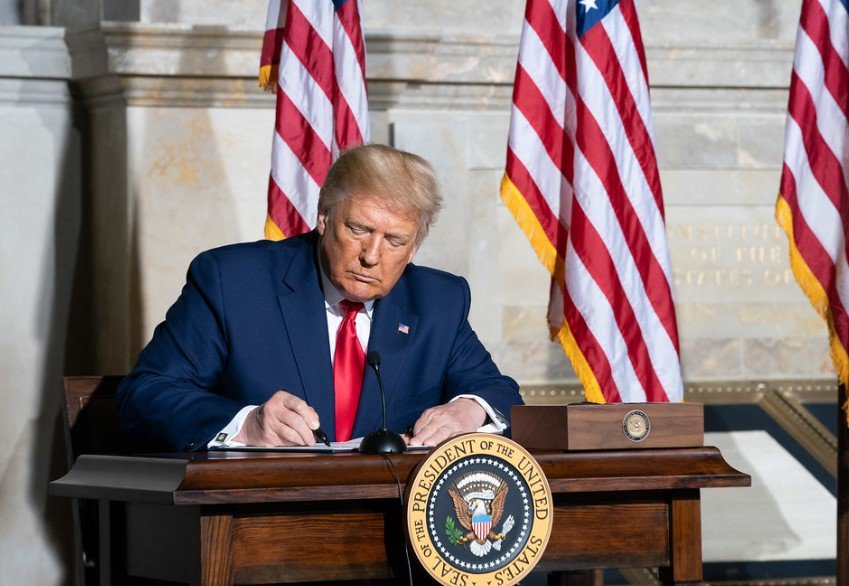President Donald Trump announced on August 25, 2025, that he wants to pursue more government investments in major US companies, similar to the recent deal where the government took a nearly 10% stake in Intel. This move, revealed during a White House briefing, has raised alarms among business leaders who worry it signals a shift toward greater state control over the economy.
Details of the Intel Agreement
The White House finalized the Intel deal on August 22, 2025, converting about $8.9 billion in government grants into equity. This gives the US a 9.9% stake in the chipmaker, aimed at boosting domestic manufacturing and helping Intel compete with rivals like Taiwan’s TSMC.
Trump described the arrangement as a win for America during his briefing. He recalled suggesting the idea to Intel’s CEO Lip-Bu Tan earlier in August, saying it would strengthen the company and create jobs. Intel, facing challenges with a market value of around $105 billion and $9 billion in cash reserves, agreed to the terms.
This is not a full bailout, unlike past cases. Intel remains profitable but has lagged in advanced chip production. The deal includes plans for new US factories, supported by the 2022 Chips Act, which allocated funds to reduce reliance on foreign tech.
Trump’s Push for Broader Investments
Trump made clear he sees the Intel stake as a model for future actions. “I want to get as much as I can,” he said, hinting at similar arrangements with other healthy firms. He praised the deal for making the US “richer” and boosting stock prices, noting Intel’s shares rose after the announcement.
The administration has already explored ties with companies like Nvidia and AMD, including deals allowing limited chip sales to China in exchange for a cut of profits. These steps align with Trump’s America First agenda, focusing on tariffs, trade restrictions, and direct involvement in mergers.
Experts point to recent events, such as the 2025 executive orders on tech exports, as part of this pattern. Trump argues these moves counter China’s state-backed economy, but they mark a departure from traditional US free-market policies.

Growing Concerns in Corporate America
Business leaders express unease about increased government oversight. Groups like the US Chamber of Commerce warn that such interventions could slow decision-making and deter investors. One executive, speaking anonymously, called it “crony capitalism” that favors political ties over innovation.
Intel itself highlighted risks in a recent SEC filing. The company noted potential losses in international sales due to backlash from foreign partners and governments wary of US state involvement.
- Reduced shareholder voting rights, limiting influence on company decisions.
- Possible barriers to future mergers or acquisitions that benefit investors.
- Employee morale issues from perceived government interference.
These worries echo criticisms from figures like author Walter Isaacson, who described Trump’s approach as a “scattershot method” harming long-term growth.
Critics also fear broader economic fallout. With inflation concerns from Trump’s proposed tariffs and tax cuts, the Federal Reserve has signaled no rate cuts in 2025, adding pressure on businesses.
Shift Toward State Capitalism
This strategy revives debates on state capitalism, where governments hold stakes in private firms. Unlike the 2008 auto bailouts, which were temporary, Trump’s plan seems ongoing. It draws comparisons to China’s model, which Republicans often condemn, yet now appears mirrored in US policy.
A look at historical interventions shows the change:
| Event | Year | Government Action | Outcome |
|---|---|---|---|
| Auto Industry Bailout | 2008-2009 | Stakes in GM and Chrysler | Companies recovered, stakes sold off |
| Bank Rescues | 2008 | Equity in major banks | Profits returned to taxpayers |
| Intel Stake | 2025 | 9.9% equity for grants | Ongoing, aimed at manufacturing boost |
Analysts say this could redefine US capitalism, blending public and private sectors. Supporters claim it protects jobs and tech leadership amid global tensions, like the US-China trade war.
However, opponents argue it threatens free enterprise. Recent stock market dips, including a 1,123-point Dow drop in December 2024 linked to tariff fears, underline the risks.
Potential Impacts on the Economy
The push for more deals could affect various sectors, from tech to manufacturing. Trump has mentioned interest in AI infrastructure, with billions pledged for domestic projects in January 2025. This aims to counter foreign dominance but raises questions about fairness and efficiency.
Economists predict mixed results. Job creation might rise in targeted industries, but overall innovation could suffer if companies prioritize government approval over market needs.
In the long run, this might lead to a more resilient US supply chain, especially in critical areas like semiconductors. Yet, international trade partners could retaliate, complicating global business ties.
What do you think about Trump’s strategy? Share your views in the comments and spread the word to keep the conversation going.
